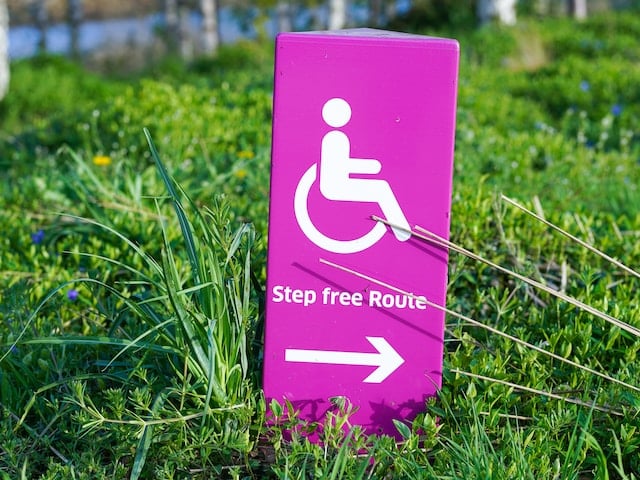Essentials
Podcasting Essentials
Related articles:
If you’ve been around the podcast scene for a while, you’ve likely heard about podcast transcripts: a text version of all of the speech, music, and other sounds in a podcast episode, written in a script-like format to allow D/deaf and hard-of-hearing audiences the same access to shows as their hearing peers.
Many podcasters (myself included) have written about the importance of transcripts. While transcripts are undoubtedly important, they’re far from the only disability accommodation that your podcast should have—however, for reasons I’m not entirely sure of, transcripts are one of the only podcast accommodations I ever see talked about. In this article, I’m going to go over disability accommodations that most podcasters don’t think about that you should consider implementing in your show.
This isn’t a fully comprehensive guide to web accessibility—if you want that, I recommend checking out the Web Accessibility Initiative. However, if you want to make your podcast more accessible and you’re not sure where to start, this article will provide a jumping off point to help you hit the ground running (or rolling).
Video captions
Many podcasters incorporate videos into their marketing strategy by posting videos to social media, uploading their episodes to YouTube, or both. While a good portion of the videos I see in the podcast space include captions, I have a recurring problem with videos that feature episode audio over a still image: they don’t identify speakers. Some go even further and don’t have any punctuation throughout the captions, making them extremely difficult—if not impossible—to fully understand.
To demonstrate why this is an issue, I’m going to mangle the transcript for the first episode of Morgan Givens’ Flyest Fables. Givens’ transcripts are excellent, having clear speaker IDs and alternating between left, right, and center alignment to convey how the audio plays through headphones. But if they were written in the same manner that many podcasters write their video captions, they might look something like this:
his tormentors had stopped running and stood dazzled in the parking lot where is he how did he do that he was just right here he turned around ready to break into a light jog but his foot caught on a root tweaking his ankle seriously
Can you tell where each sentence is supposed to end? Can you tell when the dialogue switches between different voices? Can you even tell how many people are speaking? (Five, if you’re curious). Would you be able to make any sense of it at all if it was part of a social media video, broken up into 4-5 word fragments that were only on screen for a few seconds each?
Additionally, be mindful about where you place your captions—most social media websites have a user interface that obscures part of the screen, and if you place your captions under that, they’ll be impossible to read. Place them around the middle of the screen, and if there’s something in the video that you want viewers to look at, place the captions close to the action (without obscuring it) so that D/deaf viewers don’t have to choose between watching the video or understanding what’s being said.
 Website accessibility
Website accessibility
If you have a podcast, you should have a website for your show—and you should make it as accessible as you can. There are a wide range of disabilities that can make navigating the internet difficult; here are some of the ways you can account for those in your website design. Think about screen readers
Some visually disabled people navigate the web through the use of a screen reader: a type of assistive technology that renders visual web content to either braille or (more commonly today) a voice output. To make sure your website is accessible to screen readers, there are a few things to keep in mind.
Alt Text
Alt text for informational images
Alt text is a small piece of text attached to an image to describe either its appearance or its function. For images that add something important to the experience of browsing your website or social media, but aren’t vital to navigating the page—think things like cover art, headshots of the team, or art of the characters—just put in a short description of what the image is portraying. If I wanted to describe the cover art for Dylan Marron’s Conversations with People Who Hate Me, I might write something like:
Dylan Marron speaks into a red telephone connected to a laptop by a cord. A speech bubble above Dylan reads “Conversations with People Who Hate Me” and text below that reads “with Dylan Marron”. A “dislike” button is coming out of the laptop towards Dylan.
The way you describe the image will change depending on its context and purpose. Podcast cover art is meant to communicate what the show is about, so I stuck with information that I thought would do that. I didn’t describe what Dylan looked like here, but if I was writing alt text for one of Dylan’s headshots, I’d probably describe his appearance more. Similarly, I didn’t describe the colors or overall aesthetic of the art, but I probably would if I was describing the image for an article about podcast cover art design.
Generally speaking, you want to keep alt text fairly short and simple—and, very importantly, you want to keep it objective. Don’t include your own personal opinions, even if they’re positive; “An oil painting” is better than “A beautiful oil painting”.
Alt text for decorative images
A decorative image is one that doesn’t convey any important information. According to most web accessibility guidelines, decorative images don’t require alt text. However, in the podcasting world, it can be a little fuzzy what counts as a decorative image and what does not. For social media, I recommend erring on the side of always using alt text—a social media website where none of the images have alt text would, in essence, be a social media website that people with visual disabilities could only truly experience a fraction of.
For your website, it really depends on the specific image and what its purpose is. A transparent PNG serving as a line break on your about page may not warrant a description if it’s really just there for aesthetics, or it may be necessary to describe if it breaks up the text in a way that’s important for clarity.
Alt text for functional images
Functional images are vital for navigating and understanding a webpage—if you’re using images for things like headers or buttons, those are functional images. For this type of alt text, you actually don’t want to describe the image’s appearance; you just want to describe what its function is. So, for example:
 If this was a header in a blog post or on an about page, I would write the alt text as “About Me”.
If this was a header in a blog post or on an about page, I would write the alt text as “About Me”.
 If this was a button that opened a contact page, I would write the alt text as “Contact” (or “Contact Me” or “Contact Us”).
If this was a button that opened a contact page, I would write the alt text as “Contact” (or “Contact Me” or “Contact Us”).

If this was a button that launched a search bar, I would write the alt text as “Search”.
Design
Format your hyperlinks properly.
Hyperlinked text should describe what the link leads to; don’t hyperlink text that just says something like “link” or “click here”.
Instead of “For more information about our show, click here” (with “click here” hyperlinked), write “Read more about our show” (with “about our show” hyperlinked).
Instead of “Check out our cast list here! [Link]” (with “[Link]” hyperlinked), write “Check out our cast list!” (with “cast list” hyperlinked).
Use colors carefully.
Nothing on your website should necessitate color to understand—some people are color blind and see either distorted colors or no color at all; others can see color, but set their devices to display in grayscale due to another disability (e.g. chronic migraines). Try viewing your website in grayscale. Is all of your text legible? Do the buttons stand out from the background? Is it easy to figure out where to find everything?
Avoid seizure triggers.
Moving geometric patterns (like stripes or checkers) and flashing lights can trigger seizures in people with photosensitive epilepsy—and even people without epilepsy may feel disoriented, sick, or uncomfortable after looking at them. If you feel strongly about including these effects in videos, please put a warning at the beginning so that people can click away if they need. For your website itself, just leave it off entirely. It’s not worth the risk of injuring someone.
Make things easy to click.
Tiny scroll bars, small buttons, and anything else that requires clicking a very small and specific area can be difficult or impossible to navigate for people with a disability that causes issues with fine motor control, like Down syndrome or arthritis. Err on the side of making things like scroll bars and buttons large (yes, even if you think they’d look better small—aesthetics don’t trump accessibility).
Memory issues
Like many people—probably more than you think—I have a disability that impacts my memory. A struggle that I regularly have with fiction podcasts is keeping track of the characters and plot points, particularly in shows that are long-running and/or have a large cast. There are two big things that really help me that I would be thrilled to see more of:
Character profiles
Most websites for podcasts include information on the cast, but very few include information on the characters they play. One of the only ones I can think of that does is Wolf 359. The Wolf 359 character profiles have a strong visual design, with information about the characters that matches the writing style of the show itself. If you don’t feel equipped to make something like that, your character list can be a lot simpler—you can just do a bullet point list that looks something like:
- Doug Eiffel: He/him. The station’s communications officer and resident rule-breaker. While long-term planning isn’t his strong suit, he makes up for that by being clever and quick on his feet.
- Renée Minkowski: She/her. The station’s de facto commanding officer. Minkowski is an accomplished pilot, a chronic overachiever, and a closeted lover of musical theatre.
Episode summaries
Having official summaries of all of the key points in each episode would be a massive help for people who struggle to remember what’s happened in previous episodes. I don’t think I’ve ever seen a show do this before, but I would really love to see shows start to do it, because it would make shows a lot more accessible to me!
Both fiction and episodic nonfiction shows could do this: for fiction, episode summaries could include a plot recap, big revelations, and any changes in the characters or their relationships with each other; for nonfiction, they might instead include a list of topics that were discussed, any important takeaways, and things that are likely to be referenced again in future episodes.
Content Warnings
While content warnings are a great way to make your show more accessible, they can be strangely controversial. Some people claim that they’re censorship, which has always been nonsensical to me, as content warnings don’t in any way dictate what content you can and can’t have in your show. Other people, particularly in the fiction space, claim that content warnings would spoil their big twists and reveals. And, sure, content warnings can remove the element of surprise—but they’re great for creating suspense, which is much more narratively juicy.
Alfred Hitchcock once described the difference between suspense and surprise like this: if you show a group of characters talking around a table, and then have a bomb hidden under the table explode out of nowhere at the end of the scene, you’ll certainly surprise the audience. However, if you start by showing the bomb, the audience will be on the edge of their seats for the entire scene as they wait anxiously for the bomb to go off, hoping desperately that someone will discover it before it does. Rather than fifteen seconds of surprise, you’ve given them fifteen minutes of suspense.
I believe that content warnings can be used to the same effect. The content warnings for the eighth episode of Valence, “Ghosts”, state that the episode includes an on-screen panic attack and a discussion of death, both starting at the same timestamp. Between the episode title and the content warnings, the message was clear: somebody is going to die. The first time I listened, I was kept in delightfully agonizing suspense through the episode, wondering which of the beloved characters we were about to lose.
I truly wish that more artists would approach accessibility from this viewpoint: not throwing their hands up and saying “I simply can’t! It would ruin my art!”, but instead thinking about how accessibility can enhance rather than hinder their artistic expression.
Live Shows
If your podcast has live shows, there are a few things you can keep in mind to make them more inclusive.
Live captioning and interpretation
If you’ve got an in-person live show, your best bet for D/deaf accessibility would be getting an interpreter fluent in your local sign language. If you’re not certain if there will be D/deaf audience members at all of your shows, consider including a note in the event description that audience members who need sign language interpretation can contact you and you’ll arrange for an interpreter.
For online shows, you can either do interpretation or live captioning—a form of closed captions where a transcriptionist watches the show and types up captions as words are spoken. Please note that live captioning is very different from auto captions, which are often so bad they’re basically useless.
Accessible venues
If you have multiple options for venues, please prioritize finding one that’s accessible for people with mobility issues. If you only have one option for your venue, be proactive about finding out what their accessibility looks like and including that with all of the other information you distribute about your show. Please don’t make disabled fans have to spend an hour getting shuffled around a phone tree just to find out the venue is only accessible via stairs.
Avoid ableist topics, themes, and behaviors
An issue that I and many other disabled podcasters have had for a long time is that there’s a huge ableism problem in the podcasting field—not just from the bigots you’d expect it from, but also from otherwise progressive podcasters, some of whom are even disabled themselves. Some of the things that I’ve seen from my colleagues include:
- Jokes about stigmatized mental illnesses, like personality disorders and schizophrenia
- Jokes about mental hospitals, lobotomies, or forced institutionalization
- Armchair diagnosing people (either fictional or real) with personality disorders to explain their poor behavior
- Jokes about incontinence, or using the idea of an adult wearing diapers as an insult
- Jokes about adults who still live with their parents or who struggle to cook/clean
- Making fun of people who don’t understand social cues, sarcasm, or “unwritten rules” in the podcasting industry
- Talking over disabled people while acting like they’re advocating for the people they’re talking over
Here’s the thing: your show can be the most accessible show on the planet, and it will mean absolutely nothing if the way you conduct yourself reveals that you subconsciously view disabled people as lesser. And disabled people absolutely are not immune to this—it’s very possible for disabled people to be laterally ableist towards people with other disabilities. I’ve dealt with physically disabled people saying cruel things about my mental disabilities and mentally disabled people saying cruel things about my physical ones. I’ve seen people with anxiety make mean-spirited jokes about borderline personality disorder and people with depression say that schizophrenic people are dangerous.
Whoever you are—whether you’re disabled or currently abled, whether you’re gay or trans or part of any other marginalized group—you are capable of being ableist. And if you want your podcast to be inclusive to disabled people, you have to be honest with yourself about ableist behaviors you might have exhibited and what you can do to change them going forward.
While this article isn’t a fully comprehensive list, it should be a good place to start. If you integrate even a few of these practices into your show, you’ll contribute to making the podcasting world more accessible, one show at a time.

